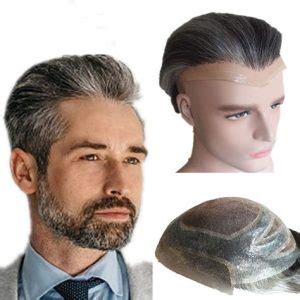Toupee system pins are an essential component in maintaining a secure and comfortable fit for hair replacement systems. Their selection and installation can greatly impact the user experience. Here are three key factors to consider when choosing toupee system pins:

1. Pin Type:
• Pressure-sensitive (Adhesive):
- Pros: Convenient, self-adhesive, and eliminates the need for additional adhesives.
- Cons: May not be as secure as mechanical pins, especially in humid or oily environments.
- Suitable for: Temporary or partial hair systems.
• Mechanical:
- Pros: Provides a secure and long-lasting hold.
- Cons: Requires tools for insertion and removal, and may be more visible.
- Suitable for: Full and permanent hair systems.
2. Pin Size and Shape:
Pin size and shape determine the level of comfort and hold.
- Smaller pins (3-4mm):/ Provide less hold but are more comfortable, suitable for thin or sensitive scalps.
- Larger pins (5-6mm):/ Offer a stronger hold but may be less comfortable, suitable for thicker or oily scalps.
- Round pins: Roll smoothly and are less irritating, ideal for sensitive scalps.
- Flat pins: Provide a more secure hold but may be more visible.
3. Pin Material:
The material of the pins affects durability and comfort.
- Stainless Steel: Strong, durable, and hypoallergenic.
- Titanium: Lightweight, strong, and biocompatible.
- Gold: 貴金属, hypoallergenic, but more expensive.
- Platinum: The most expensive option, hypoallergenic, and highly durable.
Additional Considerations:
- Number of Pins: Generally, 3-6 pins are sufficient for a secure hold.
- Pin Placement: Pin locations should distribute pressure evenly to prevent scalp irritation.
- Adhesive Reinforcements: For added security, consider using an adhesive strip or patch to reinforce the pins.
Common Mistakes to Avoid:
- Not using the correct pin type or size for the scalp and hair system.
- Installing pins too tightly, causing discomfort and scalp damage.
- Inserting pins at an angle, weakening the hold.
- Using excessive adhesive, which can lead to scalp irritation.
Conclusion:
Toupee system pins are a crucial element in achieving a secure and comfortable fit for hair replacement systems. By understanding the different types, sizes, materials, and considerations, users can make an informed choice that optimizes their hair system experience.
FAQs:
-
How often should pins be replaced?
– Replace pins every 1-2 weeks to maintain optimum hold and hygiene. -
Is it possible to use pins with different hair systems?
– No, pins are designed specifically for the type of hair system being used. -
What if pins cause scalp irritation?
– Use smaller pins, adjust their placement, or consult a hair system specialist. -
Can pins be reused?
– No, pins should be replaced each time the hair system is removed and cleaned. -
What other options are available besides pins?
– Other attachment methods include tapes, clips, and adhesives. -
How can I ensure the most secure hold from pins?
– Use the correct pin type, size, and material. Install pins at an angle and use additional adhesive reinforcements as needed. -
What is the average price range for toupee system pins?
– Prices vary depending on the type, material, and quantity of pins, ranging from $15-$100. -
Where can I find high-quality toupee system pins?
– Reputable hair system suppliers and online retailers offer a wide selection of pins to meet specific needs.
